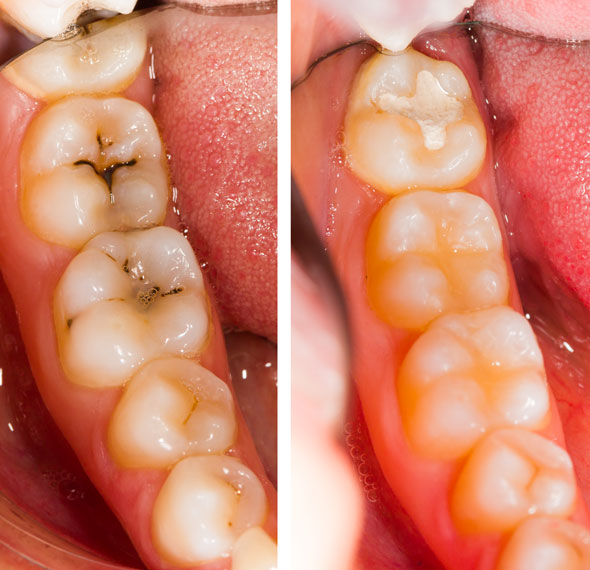Bonding & Fillings
When a tooth has a minor chip, crack, discoloration, or decay, dental bonding can be a simple way to cover these flaws. The bonding material is tooth colored that completely blends with the rest of the teeth. By being white, these dental fillings restore and mimic the natural appearance of tooth structure.
 Is dental bonding right for you? It may be an option if you would like to:
Is dental bonding right for you? It may be an option if you would like to:
- Repair decayed teeth
- Change the shape of your teeth, making them appear to be more straight or even
- Improve the appearance of discolored teeth
- Close gaps/spaces in your teeth
- Protect a tooth root that may be exposed when the gums recede
What are the advantages of tooth colored fillings (white fillings)?
- They closely match natural tooth color and appearance.
- They bond to tooth structure chemically and thus do not require the placement of slots, grooves or pins in healthy tooth structure to mechanically retain them.
- The bonding of white fillings to the tooth restore 85% – 95% of the original strength of the tooth.
- They completely harden in seconds instead of days required by some other materials.
- Tooth sensitivity, if any, due to composite resin use is minimal and brief.
- They may be used on front and back teeth without compromising esthetics or strength.
- If damaged they can be repaired.
Crowns and Bridges
A crown is a “cap”, that is tooth shaped. It is placed on top of a tooth to restore its function, shape and size as well as improve aesthetics.
It may be needed to:
- Protect a weak tooth or cracked tooth
- Cover a tooth that has had a root canal
- Cover a dental implant
- Restore a broken or decayed tooth
What are dental bridges?
Dental bridges are permanent dental appliances made to replace missing teeth. These bridges can be supported by natural teeth or created with implants. It is important to create a bridge when you have missing teeth, to prevent shifting of the natural teeth. Bridges are natural looking, allow for comfortable chewing and can be easily cleaned and maintained.
Dental bridge and crown procedure:
During the first appointment, the tooth is prepared and shaped. An impression of the tooth is taken and a temporary crown is placed. The impression is then sent to a dental laboratory to fabricate a custom designed crown. At the second visit the dental crown, and/or bridge is cemented and the procedure is complete.
Caring for your crown on bridge:
It is very important to take good care of the crown of bridge with proper brushing and flossing. A quality crown or bridge can last many years. If you grind your teeth, your dentist may recommend a mouth guard to protect your new crown and the rest of your teeth.
Inlays and Onlays
Placing an inlay or an onlay may be necessary if the tooth is damaged to the point of not being a candidate for a filling. By placing an inlay/onlay, this will eliminate tooth sensitivity in the decayed tooth, and will reduce the likelihood of losing that tooth.
An onlay restores a large area of a tooth, while an inlay lies inside the tips (cusp) of the biting surface of the tooth. Inlays and onlays can be placed when teeth are cracked or are chipped.
Inlays and onlays are laboratory-processed ceramic restorations manufactured to match the natural color of the tooth. Inlays are approximately filling size without the inclination to break-down over time the way a traditional amalgam filling does and are cemented in place. Onlays are more conservative than a full coverage crown.
